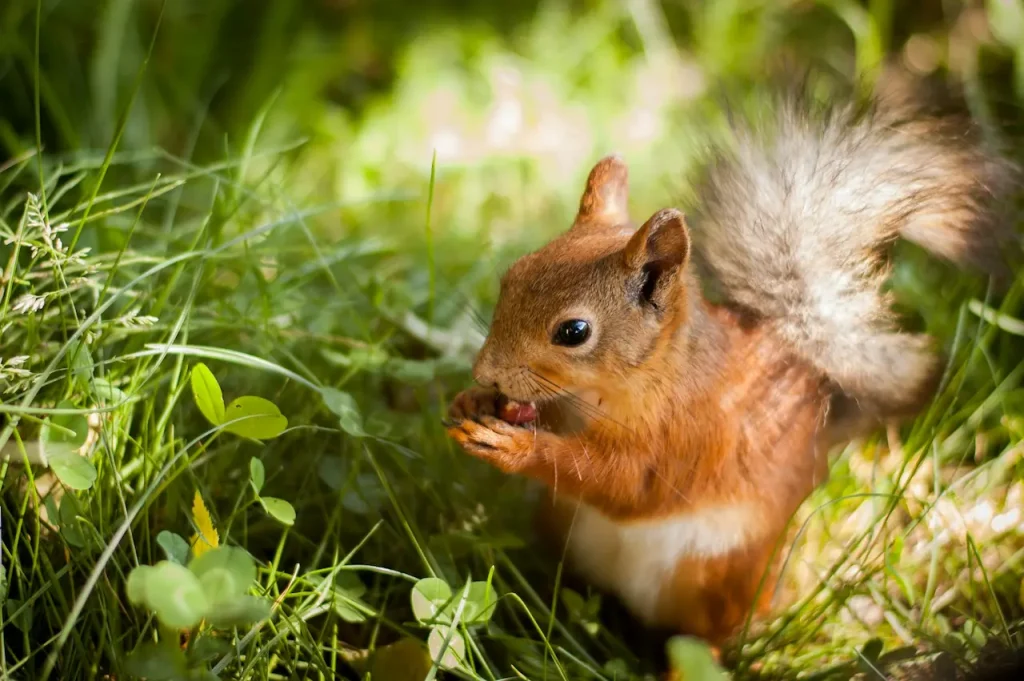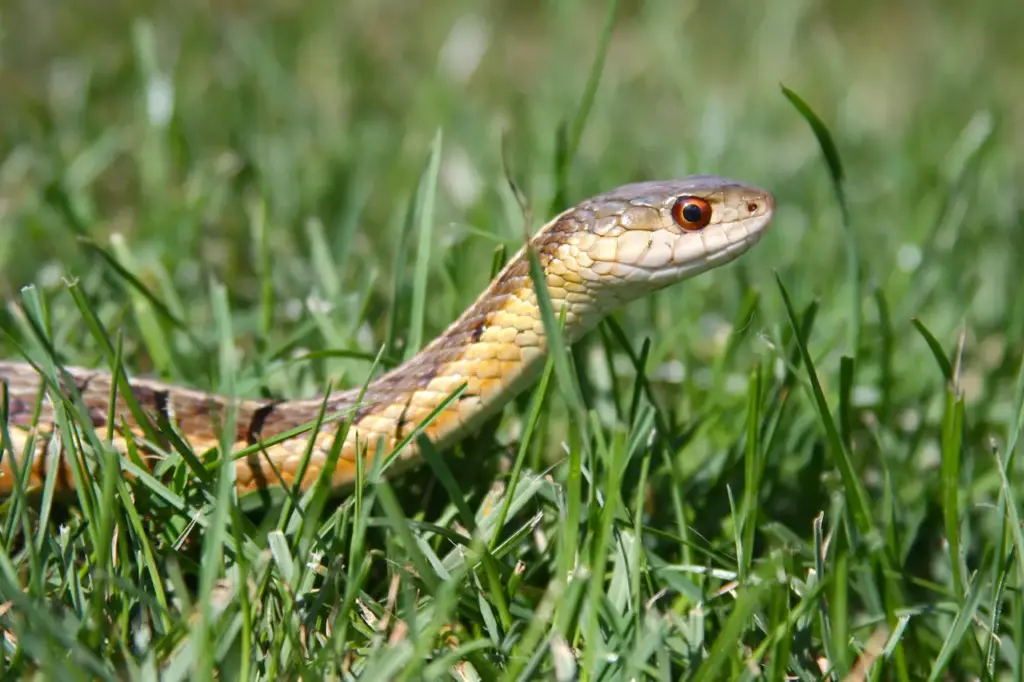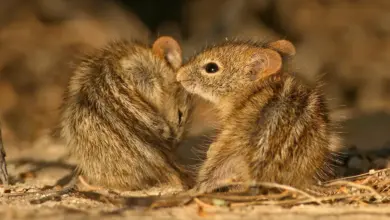Squirrels have plenty of predators, or natural enemies. They are often attacked by flying predators such as hawks and owls.
On the ground, squirrels need to be on the lookout for all the foxes, coyotes, wildcats, weasels and snakes that eat them whenever they get a chance.
And some four-footed predators, such as fishers and pine martins, even chase squirrels through the trees in order to make a meal of them.
And, what does a squirrel eat? Squirrels eat a variety of nuts, seeds, fruits and other types of vegetation.

Introduction
Squirrels seem more common than any other rodent, growing in almost endless populations wherever there are trees. With their bushy tails and fast movements, these are frequently seen in parks, woodlands, and cities. These cuddly animals play various roles in ecosystems, including predators, prey, and even gardeners!
This article will examine squirrel predators and the foods squirrels consume, revealing a web of relationships within the natural food chain. We’ll also learn about squirrels’ nutritional needs, including fruits, nuts, vegetables, and rare activity in bug and bird nests.
For a closer look at each of these frequent squirrel-eating predators, continue reading. We’ll also discuss the adaptations squirrels have made to their environment to allow them to survive.

In the Wild, How Do Squirrels Survive?
More than 60 kinds of squirrels are found in the United States alone, although they fall into three main categories: tree, ground, and flying squirrels.
The most possible thing that comes to mind when you hear the sound “squirrel” is a tree squirrel. As their name implies, these animals spend much of their time in trees, making their nests.
Although they are adept climbers, ground squirrels reside in underground colonies. They are distinct from the other groups of squirrels in that they rather dwell on broad plains and deserts than close to woods.
Lastly, a remarkable modification that allows flying squirrels to glide over 150 feet separates them from tree squirrels: an additional elastic skin part between their arms and legs. Interestingly, while all squirrel species can withstand falls from any height, flying squirrels can glide and control their descent.
Although each of these squirrel species inhabits a distinct habitat, they often have similar behaviours, survival strategies, and predators depending on the area.
The Squirrel Is Extremely Agile
The squirrel’s ability to surpass and outmanoeuvre most other animals is its most effective means of avoiding predators. This ability is based on a variety of their unique adaptations.
With a top speed of 20 miles per hour, squirrels’ ability to move fast is their primary defence against most predators. Furthermore, they are skilled climbers who can put space between themselves and whatever is pursuing them by sprinting up a tree and leaping to the next one in seconds.
In addition to their exceptional speed, squirrels weigh relatively little relative to their entire size. This contributes to their ability to run quickly and allows them to access areas where more giant predators cannot.
Because of their solid hind legs, squirrels can jump great distances and seem to resist gravity as they fly up from tree to tree. In relation, squirrels can jump four times farther than an Olympic long jumper—well over 20 times their body length.
Squirrels Defend Their Territory Extraordinarily!
Despite their small size, squirrels may be fierce and can fight to protect their home from intruders and other members of their species.
Squirrels are very agile, have sharp fangs and claws, and can fight against any creatures that try to invade their area. Red squirrels are among the most aggressive kinds of tree squirrels.
If you’ve seen two squirrels becoming playful, it’s more likely that they are resolving a territorial disagreement. A squirrel’s home range can span up to 20 acres or be as tiny as a few trees.
Since squirrels are skilled at choosing their battles, they often flee from giant predators rather than fight back.
Squirrels even mark particular areas as their territory and choose to nest in them throughout the winter.
Squirrels Always Remain Aware Of Their Surroundings
A squirrel’s ability to continuously sense its environment is essential. If they are not taken by surprise, they stand a decent chance of avoiding most predators.
If you observe a squirrel at any time, you will notice that it is constantly scanning its surroundings and listening for dangers. Because of its ability to keep its head turned, squirrels can quickly respond to unanticipated movements by running to safety.
A squirrel’s ability to see with both eyes—its peripheral and focused vision—allows it to be even more aware of its environment. A squirrel can see up ahead, below, and to either side without rotating its head.
Predators Of Squirrel
1. The Birds of Prey
Predatory birds of prey, like hawks and owls, are ferocious predators renowned for their quick reflexes and keen vision. Among their favourite prey are squirrels since they provide a wholesome feast.
Hawks search the ground and trees for unsuspecting squirrels using their acute vision. With startling speed, they jump underneath and seize their prey securely with their keen claws.
The squirrels are unsafe in any environment since the hawk is excellently manoeuvrable in the air and can identify prey from afar. Hawks fly over, looking for signs of activity on the ground from their perch in the sky. When a hawk sees its prey, a squirrel, from its perch, it rushes to its victim with lightning speed, having its talons spread, hoping to clasp its prey before it sprints along the tree branches or flies up into the air.
In contrast, with stealth, owls pursue squirrels under the cover of darkness. Their strong talons and stealthy flying make them effective predators that can surprise squirrels and capture them. The squirrels can sometimes avoid these expert bird hunters even with their outstanding agility.
The owl is a good predator of the squirrel species. It is a night predator that has been known to stalk squirrels with its silent flight and highly advanced hunting skills. At night, owls hunt, knocking on wooded areas of their domain, and detect the slightest movement of a squirrel using their keen hearing.
The owl’s reasons for hunting are its deadly precision and the swiftness of its wings, which allow it to attack before squirrels sense danger. Since day life is their annual activity and they live in trees, squirrels have no luck at all; nighttime is prevailed by a sense of fear.
They cannot outpace the owl’s hunting speed and sneaking moves in spite of their running and jumping capabilities. Due to their formidable power at night hunting and strong survival instincts, owls contradict the squirrel.

2. Carnivorous Mammals
Naturally, foxes and coyotes are among the carnivorous creatures that prey on squirrels. These mammals can easily follow and catch squirrels because of their excellent senses and natural hunting instincts.
Due to their crafty nature, foxes frequently chase squirrels in vast fields or forested regions. They use patience and stealth to await the right opportunity to attack their unsuspecting victim. Foxes as they are dangerous predators that pose a severe risk to squirrels out and about in populated areas because of their agility and stealth. Due to their cunning and flexibility, foxes are important squirrel predators in various environments.
These quick dogs are skilled hunters who use speed and stealth to kill their prey. Due to the abundance of squirrels in forests, fields, and urban areas, foxes frequently monitor these boundaries.
When foxes notice squirrels’ presence, they actively chase them using their keen sense of smell and vision. Then, they get closer to their prey through quick sprints and deft jumps. Because of their exceptional sensitivity and skill in the woods, squirrels may try to avoid foxes by hiding in tunnels and hollows or rushing between trees.
Coyotes also hunt squirrels in urban and suburban areas, where they benefit from the abundance of food supplies found in landscapes dominated by humans. Coyotes are adaptive animals that live in a variety of areas, where they prey on their victims.

3. Domestic Pets
Animals we don’t usually consider about what eats wild animals are domestic pets, such as dogs and occasionally more giant cats, may threaten squirrels, particularly in urban and suburban areas where pets can wander freely. Even though they may not be squirrels’ natural predators, these animals may become predatory when they come into contact with these little rodents.
Dogs may chase squirrels with liveliness due to their keen sense of smell and pursuing impulses, which might result in confrontations. Dogs are unable to climb trees, so they pursue squirrels until they tire out. If the squirrels manage to climb a tree, the dogs will wait for them to descend. Packs of wild dogs exhibit dogs’ natural hunting instincts, which are applied in hunting situations when animals are pursued up trees in order for their owner to arrive and complete the task.
More giant cats—like some domestic cat breeds or wild cats—may also see squirrels as prey, especially if they’re when they are hungry. Even though they are smaller than their wild counterparts, domestic cats are adept hunters who can surprise unsuspecting squirrels with lightning-fast leaps. Squirrels may find it difficult to protect themselves against the cunning approach of a domestic cat since they are habitual to pass over natural obstacles and avoid wild predators.
Some pet owners may prevent their animals from pursuing squirrels, while others might need to be made aware of the possible harm their animals could cause to wildlife. Consequently, there is more insistence on eating squirrels in regions often visited by household pets.

4. Snakes
Because of their cunning and shambling motions, snakes seriously threaten squirrel populations in many parts of the world. Certain species, including pythons, black racers, and rat snakes, have become proficient predators of small animals, such as squirrels.
Snakes can identify squirrels in their environment due to their acute sense of smell and heat-sensing pits. When a squirrel and a snake meet, the predator moves quickly to attack, either biting its victim with poison or tightly coiling around it. Because of their natural agility and aptitude for climbing trees, squirrels may try to hide under the protection of tree limbs or thick undergrowth.
Because they can run away and use their strong teeth and claws to fight their way out when snakes seldom consume necessary adult flying and tree squirrels.
However, if they are trapped on the ground or in a precarious posture, they become simple pickings for the snake’s deadly embrace. Snakes exhibit the complex interactions between predators and prey in the natural world by controlling squirrel populations and influencing ecological dynamics.

What Do Squirrels Eat?
1. Nuts And Seed
Squirrels eat nuts and seeds, which are high in nutrition and energy. With the help of their powerful jaws and keen incisors, squirrels can break through tough shells and extract the nutrient-rich kernels within. Squirrels love to gather and store nuts, especially acorns, walnuts, hazelnuts, and pecans, in case of a shortage.
Squirrels eat nuts and various seeds from plants, including pine cones, sunflowers, and maple trees. These seeds are an essential food supply throughout the year and keep squirrels nourished during times of famine.
2. Fruits And Berries
Sweet, juicy fruits are squirrels’ favourite food, and they eat them whenever possible. Fruits that squirrels eat with great enthusiasm include apples, berries, grapes, and oranges; they love these fruits’ natural sugars and juicy flesh.
Since they frequently bury or store fruits and seeds for later consumption, squirrels are essential to spreading seeds. They unintentionally sow seeds in other places throughout the process, which helps plant populations regenerate. Certain fruits are eaten immediately, while others are kept in tree cavities or underground caves for the winter. Throughout the year, squirrels make sure their nutritional demands are satisfied by consuming a wide variety of fruits and berries.
3. Vegetables And Fungi
Squirrels are primarily herbivorous but occasionally eat vegetables and fungi as opportunistic eaters. When the chance presents itself, squirrels may try plant-based items, including corn, carrots, pumpkins, and mushrooms.
In agricultural regions, squirrels have been known to ruin farmers’ livelihoods by raiding crops, including cornfields. Although they make up a smaller portion of their diet than nuts and fruits, squirrels may add vegetables and fungus to their diets to receive essential vitamins and minerals.
However, one must use caution while eating some mushrooms since some species may poison squirrels and other creatures. Squirrels live primarily on nuts, seeds, and fruits. However, they may occasionally visit vegetable and mushroom patches.
4. Insects And Invertebrates
Although primarily herbivorous, squirrels may sometimes add insects, grubs, and worms to their diet. To satisfy their nutritional demands, squirrels may actively search for food high in protein during mating seasons and when they are expending a lot of energy.
When accessible, squirrels may eat a variety of insects, including grasshoppers, beetles, and caterpillars. They may use their excellent sense of smell and acute vision to identify possible prey as they search for insects on the forest floor, in leaf litter, or between tree limbs.
Although they are not squirrels’ primary food source, insects and other invertebrates are essential additions, especially for young squirrels learning to hunt and for adults when they need more energy.

5. Bird Eggs And Nests
Squirrels occasionally turn to predatory behaviour, breaking into bird nests to eat the eggs or young chicks. Although squirrels are mainly herbivores, they occasionally prey on bird nests when there aren’t many other options for nourishment. This behaviour is increasingly frequent in urban and suburban areas, where squirrels may come upon bird nests in trees, bushes, or building eaves.
Squirrels are more petite than raptors or predatory animals, as they are agile enough and able to climb to higher nest sites. Once inside, they may eat eggs or young chicks, depriving bird parents of their young and affecting the local bird population. Although squirrels seldom prey on birds, when they do, it shows the versatility and opportunism of these cunning rodents in their search for food.

Final Words
With their entertaining tricks and essential ecological acts, squirrels are a perfect example of how linked nature’s complex network is. They support the health and variety of ecosystems worldwide by acting as seed dispersers and prey.
We can better understand the fragile balance of life in the natural world by looking at squirrel predators and their food choices. Even though all of these predators are proficient hunters, the majority still require assistance to stay up with the quick squirrel. Every creature is essential to preserving ecological balance. Take a minute to appreciate the intricacy and beauty of nature’s food chain the next time you see a squirrel scurrying through the woods or hear a bird of prey calling from a distance.
By upholding awareness and sustainability, we can ensure the survival of these charming species and safeguard the diverse range of life on Earth.




